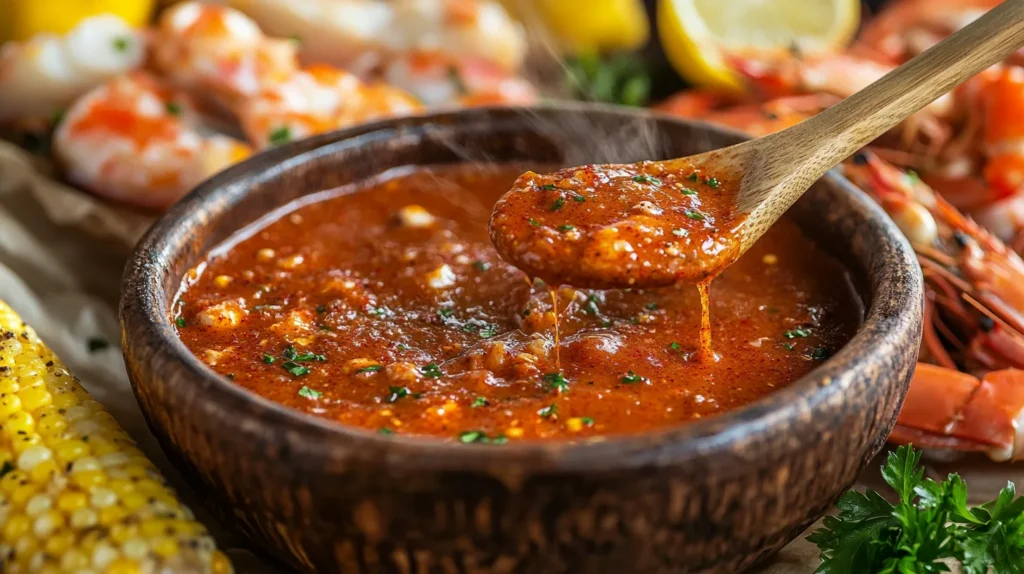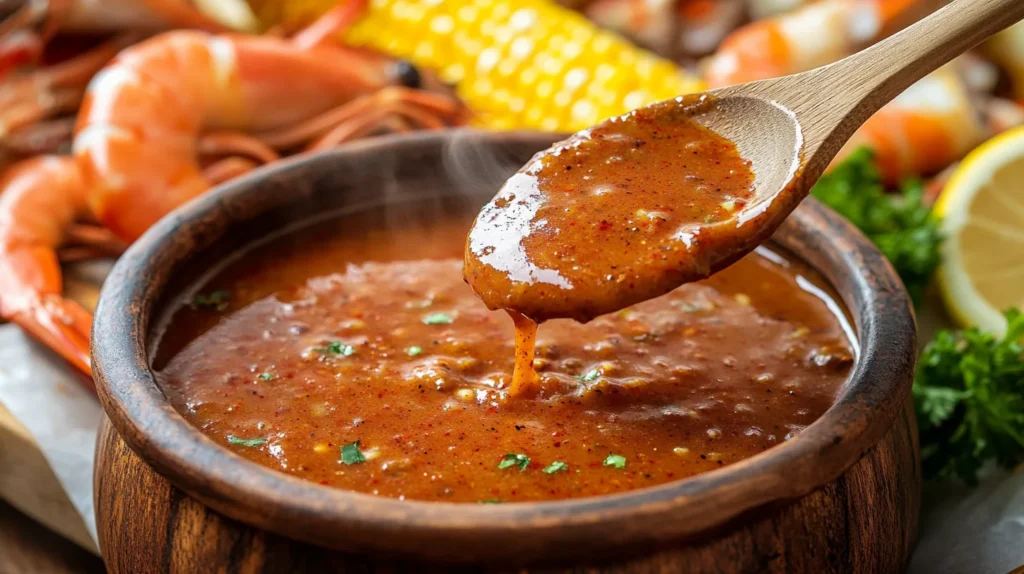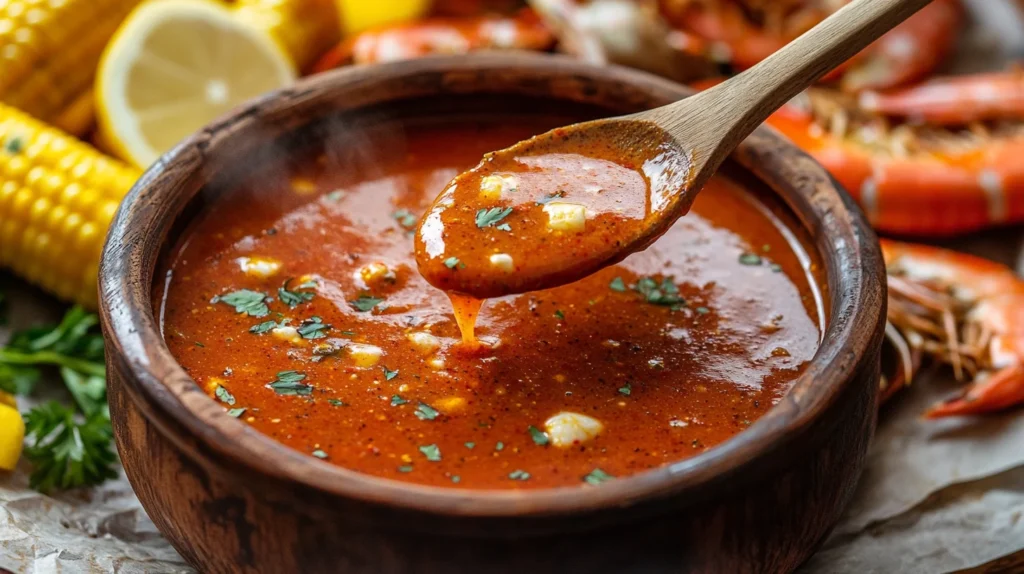If you’re a seafood lover, there’s nothing quite like the experience of a good seafood boil. Nestled among the vibrant colors and tantalizing aromas lies an essential component that elevates this culinary delight—the Seafood Boil Sauce Recipe. This article delves deep into crafting the ultimate seafood boil sauce, exploring its fundamentals, classic recipes, and advanced techniques for perfecting your flavor profile.
Understanding the Fundamentals of Seafood Boil Sauce
Before diving into specific recipes and it’s vital to understand the foundational elements that make up a fantastic seafood boil sauce. It’s not just about throwing together a list of ingredients; it’s about creating a symphony of flavors that perfectly complements the seafood, potatoes, corn, and other accompaniments.
The Essence of Flavor:Key Ingredients Explained
When it comes to seafood boil sauces and the ingredients you choose have a significant impact on the final flavor. Knowing how to mix and match these components will lead you to a sauce that’s truly unforgettable.

Base Liquids: Water, Broth, and Beer – Pros and Cons
The base liquid is the backbone of any sauce. Depending on the flavor profile you desire, you might opt for water, broth, or even beer.
Water is often the simplest choice but it lacks the depth of flavor found in broth. So Chicken or vegetable broth can add a savory touch, while beer offers a unique bitterness that balances well with the sweetness of seafood. However, it’s important to remember that using beer can also impart an alcohol flavor, which some may find unappealing.
Choosing the right base liquid sets the stage for everything else that follows.
The Spice Rack: A Deep Dive into Cajun and Creole Seasoning
Spices are where the magic happens in a seafood boil sauce. Traditional Cajun and Creole seasonings frequently take center stage, offering a robust blend of herbs and spices like cayenne, paprika, thyme, and bay leaves.
These seasoning blends work wonders for heightening the dish’s complexity. However, if you’re sensitive to heat and consider adjusting the quantities or opting for milder spices.
By understanding how each spice interacts with seafood, you can create a balanced or flavorful sauce that enhances rather than overwhelms.
Aromatic Powerhouses: Garlic, Onions, and Citrus
Garlic and onions bring aromatic richness to your seafood boil sauce. When sauted and they release essential oils that build a rich foundation of flavor.
Citrus—such as lemon, lime, or orange—adds brightness and acidity, helping to cut through the richness of the sauce.
These aromatics should be utilized thoughtfully, allowing their flavors to meld without overpowering the dish. Striking the right balance will elevate your sauce from average to extraordinary.
Fat is Flavor: Butter vs. Oil – Which is Best for Your Boil?
Fat serves as a flavor carrier in sauces. While butter adds a luxurious richness, oil can provide a lighter alternative.
For those who appreciate a hint of indulgence, incorporating butter into your seafood boil sauce will yield a creamy, delectable texture. Conversely, using a high-quality oil, like olive or avocado oil, allows the spices to shine while keeping the dish lighter.
Choosing between butter and oil ultimately depends on your personal taste preferences and dietary considerations.
The Secret Weapon: Worcestershire Sauce and Other Umami Boosters

Adding a splash of Worcestershire sauce introduces a complex umami flavor that rounds out the overall taste profile of your seafood boil sauce. This ingredient acts similarly to soy sauce or fish sauce, providing a depth that resonates in every bite.
Exploring other umami boosters, such as miso paste or anchovy paste, can also enhance the richness of your sauce. A little goes a long way, so use these ingredients judiciously to avoid overpowering your sauce.
Building Layers of Flavor: The Art of Seasoning
Creating a seafood boil sauce isn’t just about adding ingredients; it’s about layering flavors in a way that yields the most delicious results.
Start Simple: Don’t Overcrowd Your Sauce
When experimenting with flavors, simplicity is key. Beginners may be tempted to throw in everything but the kitchen sink, but this often leads to a muddled taste.
Start with a basic recipe, allowing the individual flavors to shine before introducing new ingredients. By doing so, you’ll gain a clear understanding of how different components interact, making it easier to craft a nuanced sauce.
Taste as You Go: Seasoning Adjustments for Perfection
One of the most valuable pieces of advice for crafting any sauce is to taste continuously throughout the cooking process. This practice allows you to adjust seasoning levels based on your preferences.
Remember that flavors will continue to develop as the sauce simmers, so exercise patience. If something feels off, don’t hesitate to add more spice, acid, or fat until the flavors align with your vision.
Infusion Techniques: Letting Flavors Meld and Mature
To achieve a truly knockout seafood boil sauce, employ infusion techniques that allow flavors to meld. Whether simmering your ingredients for extended periods or letting them rest overnight, infusions can lead to a more cohesive taste.
Consider steeping herbs in your base liquid or allowing spices to bloom in hot oil before adding them to the sauce. These methods create deep-rooted flavors that truly elevate the final product.
Spice Blends: DIY vs. Store-Bought – Breaking Down the Options
While store-bought spice blends offer convenience, homemade blends let you customize flavors to suit your palate. Crafting your own blends enables you to emphasize particular spices or reduce heat levels according to your liking.
Whether you decide to purchase pre-made blends or make your own, understanding the individual spices’ qualities will help you create a seafood boil sauce that’s tailor-made for your tastes.
Classic Seafood Boil Sauce Recipes
Now that we’ve explored the fundamentals, let’s dive into some classic seafood boil sauce recipes that showcase the various flavor profiles you can create.
Louisiana-Style Seafood Boil Sauce: Spicy and Authentic
Louisiana-style seafood boil sauce is revered for its bold flavors and spicy kick. To recreate this iconic sauce at home, follow the steps below.
Ingredient List and Specific Proportions
- 4 cups of chicken broth
- ½ cup of Cajun seasoning
- 3 cloves of garlic, minced
- 1 medium onion, diced
- ½ cup of Worcestershire sauce
- 1 stick of unsalted butter
- Juice of 2 lemons
- Salt and pepper to taste
Step-by-Step Instructions for Preparation
- In a large pot, combine the chicken broth, Cajun seasoning, minced garlic, and diced onion.
- Bring the mixture to a gentle simmer over medium heat, stirring occasionally to prevent sticking.
- Add Worcestershire sauce and butter, stirring until the butter has melted completely.
- Squeeze in fresh lemon juice and adjust seasoning with salt and pepper to taste.
Tips for Achieving the Perfect Level of Heat
Achieving the desired level of heat in your sauce is crucial. If you prefer a milder flavor, start with half the amount of Cajun seasoning, then gradually add more until you reach your preferred spice level.
Alternatively, preparing a side of hot sauce allows each guest to customize their serving according to their taste.
Serving Suggestions and Pairings
This zesty Louisiana-style sauce pairs beautifully with shrimp, crab legs, and lobster. Serving it alongside boiled potatoes and sweet corn adds a delightful contrast.
Don’t forget to provide crusty bread for dipping into that luscious sauce!
Garlic Butter Seafood Boil Sauce: Rich and Decadent
If you prefer a creamier, richer sauce, garlic butter seafood boil is the way to go. Its velvety texture and buttery flavor make it a favorite among seafood enthusiasts.
Ingredient List and Specific Proportions
- 1 cup of unsalted butter
- 6 cloves of garlic, minced
- 1 tablespoon of Old Bay seasoning
- 1 teaspoon of cayenne pepper
- ¼ cup of fresh parsley, chopped
- 1 lemon, juiced
- Salt to taste
Step-by-Step Instructions for Preparation
- In a saucepan, melt the butter over low heat.
- Once melted, add minced garlic to the butter, cooking until fragrant but not browned.
- Stir in Old Bay seasoning and cayenne pepper, allowing the spices to bloom in the butter.
- Finally, remove from heat and stir in lemon juice and chopped parsley. Adjust salt to taste.
Variations: Adding Herbs, Cheese, or Wine
For an extra layer of decadence, consider adding grated Parmesan cheese or a splash of white wine to your garlic butter sauce. Fresh herbs like thyme or basil can also complement the richness, enhancing the overall flavor profile.
Tips for Avoiding a Greasy Sauce
To prevent the garlic butter sauce from becoming overly greasy, ensure you’re using quality butter and keep the heat low while cooking. This will allow the garlic to soften without burning, resulting in a smoother sauce.
Citrus Herb Seafood Boil Sauce: Bright and Refreshing
For those seeking a lighter, brighter option, citrus herb seafood boil sauce is a refreshing alternative. This sauce celebrates the flavors of fresh herbs and zesty citrus.
Ingredient List and Specific Proportions
- 4 cups of vegetable broth
- 1 orange, juiced and zested
- 1 lemon, juiced and zested
- ¼ cup of fresh dill, chopped
- ¼ cup of fresh parsley, chopped
- Salt and pepper to taste
Step-by-Step Instructions for Preparation
- Start by combining vegetable broth, orange juice, lemon juice, and zest in a large pot.
- Bring the mixture to a gentle simmer and allow it to cook for about 15 minutes to meld the flavors.
- Stir in the freshly chopped herbs, adjusting seasoning with salt and pepper.
Complementary Herbs: Parsley, Thyme, and Dill
A harmonious balance of herbs is key to achieving a vibrant flavor. Parsley offers freshness, while dill adds a hint of earthiness and thyme provides warmth.
Experimenting with different herb combinations will let you tailor the sauce to your taste, ensuring it perfectly complements your seafood.
Balancing Acidity: Lemon, Lime, and Orange
The bright acidity from citrus fruits helps to counterbalance the richness of seafood. When crafting this sauce, play with the ratios of lemon, lime, and orange to achieve a flavor that pops.
Adding zest along with the juice allows for maximum flavor impact, leaving you with a sauce that’s both bright and enticing.
Leveling Up Your Seafood Boil Sauce
Once you’ve mastered the basics, consider leveling up your seafood boil sauce by incorporating advanced flavor techniques that will impress your guests.

Adding Depth and Complexity: Advanced Flavor Techniques
Creating a standout seafood boil sauce involves more than just following a recipe; it’s about developing layers of flavor that linger long after the last bite.
Browning the Aromatics: Building a Foundation of Flavor
One of the best ways to enhance the flavor of your seafood boil sauce is through browning the aromatics. Sautéing garlic and onions until they caramelize releases natural sugars, transforming them into an exquisite base for your sauce.
Taking the time to brown these ingredients will deepen the flavor, providing a delicious foundation for all the other components.
Infused Oils: Garlic Oil, Chili Oil, and Herb-Infused Oils
Infusing oils with flavors like garlic or chili can elevate your sauce to new heights. The process involves gently heating oil with your desired flavoring agents, allowing the oils to absorb those wonderful notes.
Drizzling infused oil over your seafood boil or mixing it directly into the sauce brings another layer of complexity and enhances the overall flavor.
Adding Alcohol: Beer, Wine, and Liquor Considerations
Incorporating alcohol into your seafood boil sauce introduces additional richness and depth. While beer is a popular choice, a splash of white wine or even a bit of vodka can enhance the overall flavor profile.
Be cautious with the amounts, as too much alcohol can overwhelm the sauce. Always allow it to cook down to concentrate the flavors.
Smoked Paprika and Other Smoky Flavors
For those who enjoy a smoky undertone—consider integrating smoked paprika or chipotle peppers into your sauce. This element adds a distinctive twist that can make your seafood boil unforgettable.
Experimenting with different smoky flavors can create a unique variation of your signature sauce, enticing guests with unexpected flavor notes.
Homemade Broth: Elevating Your Base Liquid
Using homemade broth instead of store-bought can significantly boost the quality of your sauce. Homemade broth allows you to control seasoning levels and incorporate fresh flavors.
Consider simmering shellfish scraps, vegetables, and herbs to create a richly flavored broth that serves as a fantastic base for your seafood boil sauce.
Sauce Consistency: Thickness and Texture Tips
Achieving the right consistency is key to a successful seafood boil sauce. A sauce that’s too thin can lead to lost flavors, while one that’s overly thick can overwhelm the seafood.
Cornstarch Slurry: A Simple Thickening Agent
A cornstarch slurry is a reliable method for thickening sauces without altering the flavor. Combine equal parts cornstarch and cold water, whisking until smooth. Gradually add this mixture to your sauce, stirring continuously until it reaches the desired thickness.
This technique allows for quick adjustments, ensuring your sauce maintains the perfect consistency.
Butter Emulsification: Achieving a Silky Smooth Sauce
Emulsifying butter into your sauce creates a silky, luxurious texture. Gradually whisk in cold butter just before serving while the sauce is warm. This technique yields a glossy finish and enhances the mouthfeel of your sauce.
Being mindful of temperature during emulsification prevents the butter from separating, allowing for a cohesive sauce.
Reducing the Sauce: Concentrating Flavors
Another effective way to thicken and intensify the flavors in your seafood boil sauce is through reduction. Simmering the sauce over low heat allows excess moisture to evaporate, concentrating the flavors.
Monitor closely to ensure you don’t reduce it too much, as a concentrated sauce can become overly salty.
Adjusting for Water Content: Preventing a Watery Boil
Understanding the impact of water content is crucial for maintaining a non-watery sauce. Make sure to account for any liquid released from the seafood when cooking, as this can dilute the flavors.
Use less base liquid than you think you need, then adjust as necessary. This approach helps maintain a bold and flavorful sauce without losing its intended impact.
Tips, Tricks, and Troubleshooting
Even seasoned chefs encounter challenges when crafting sauces. Here are some tips to help you troubleshoot common issues and achieve consistent results.
Achieving Consistent Results: Scaling Your Recipe
When scaling your seafood boil sauce recipe, maintaining flavor consistency can be daunting. Always taste as you go and adjust seasonings proportionately.
Sometimes, doubling or tripling a recipe requires slightly different adjustments, so be prepared to tweak individual ingredients to achieve the same balanced flavor profile.
Adjusting Ingredients: The Role of Taste Testing
Regular taste testing throughout the cooking process allows you to identify when adjustments are needed. Don’t be afraid to modify spices or acidity levels based on your evolving palate.
Keeping a tasting spoon handy ensures you can fine-tune flavors before serving, avoiding unwanted surprises.
Storing Leftover Sauce: Best Practices for Preservation
If you have leftover sauce, store it in an airtight container in the refrigerator. Allow the sauce to cool completely before sealing to avoid condensation.
Refrigerated sauce typically lasts for up to five days, but always check for signs of spoilage before reusing.
Reheating Leftover Sauce: Maintaining Flavor Quality
When reheating leftover sauce, do so gently over low heat to prevent scorching. Adding a splash of broth or water during reheating can help restore its original consistency.
Taste again after reheating, as flavors can shift. Adjust seasonings accordingly to ensure your sauce remains delicious.
Making Sauce Ahead of Time: Maximizing Flavor Development
Preparing your seafood boil sauce ahead of time allows the flavors to meld and mature. Prepare it a day in advance, refrigerate, and reheat before serving.
This technique not only saves time but often results in a more flavorful sauce.
Common Mistakes and How to Avoid Them
Navigating the world of sauce-making can come with pitfalls. Here are some common mistakes and how you can sidestep them.
Over-Salting the Sauce: Salting Techniques
Over-salting can ruin an otherwise fantastic seafood boil sauce. Start with smaller amounts of salt and gradually increase, tasting as you go.
Remember that some ingredients—like broth or Worcestershire sauce—can already contain salt. Factor this in before adding more.
Bland Sauce: Assessing Spices and Aromatics
A bland sauce can stem from insufficient spices or lackluster aromatics. Ensure you’re using fresh ingredients and adequate spices to achieve depth of flavor.
Layering flavors and tasting as you go are critical in preventing this issue. Don’t hesitate to ramp up the seasoning if the flavor falls flat.
Oily Sauce: Controlling Fat Content
An oily sauce can detract from the overall experience. To manage fat levels, use good-quality fats and carefully measure the quantity.
If a sauce becomes too oily during preparation, a quick fix is to skim off the excess fat with a spoon or use a paper towel to blot it away.
Too Spicy: Cooling Down the Heat
If you inadvertently make your sauce too spicy, don’t panic! Introduce a splash of acidity, like vinegar or more lemon juice, to help tone it down.
Adding a dairy component, such as sour cream or crème fraîche, can also neutralize spiciness. Remember, the goal is to create balance and enjoyment.
Conclusion
Crafting the perfect seafood boil sauce is an art form that combines understanding ingredients, mastering techniques, and a little bit of intuition. From classic recipes to innovative twists, the possibilities are endless.
Armed with this comprehensive guide, you now possess the knowledge to create a knockout Seafood Boil Sauce Recipe that will leave your guests clamoring for more. Remember to embrace experimentation, trust your palate, and above all, have fun in the kitchen. Happy cooking!
For more recipes please click on below links:
Dive into Branzino Meat: Explore its Flavor and Culinary Versatility
Easy Eggless Sausage Hashbrown Breakfast Casserole Recipe – Make Mornings Delicious and Hassle-Free

